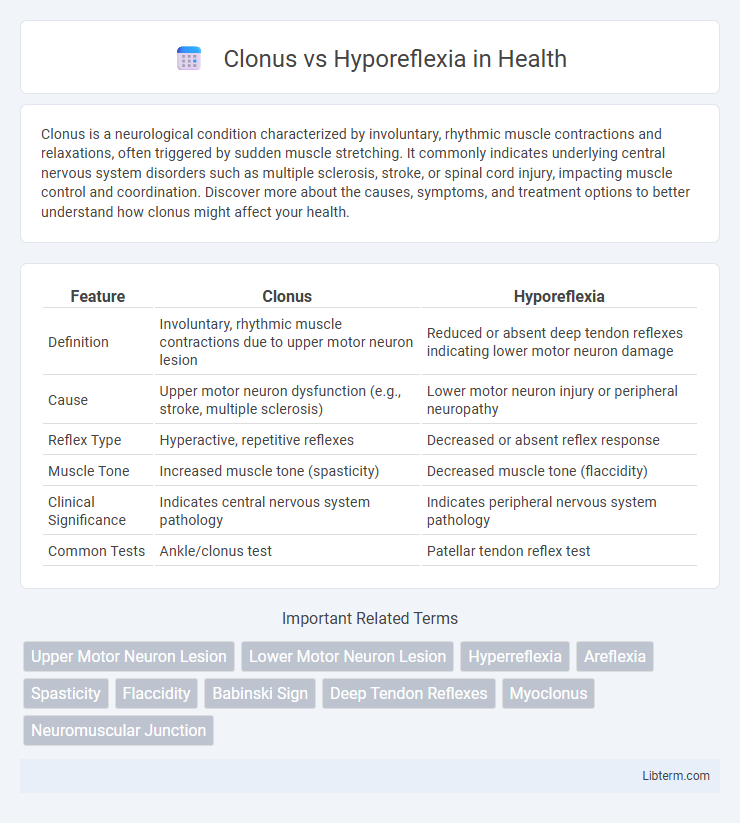Clonus is a neurological condition characterized by involuntary, rhythmic muscle contractions and relaxations, often triggered by sudden muscle stretching. It commonly indicates underlying central nervous system disorders such as multiple sclerosis, stroke, or spinal cord injury, impacting muscle control and coordination. Discover more about the causes, symptoms, and treatment options to better understand how clonus might affect your health.
Table of Comparison
| Feature | Clonus | Hyporeflexia |
|---|---|---|
| Definition | Involuntary, rhythmic muscle contractions due to upper motor neuron lesion | Reduced or absent deep tendon reflexes indicating lower motor neuron damage |
| Cause | Upper motor neuron dysfunction (e.g., stroke, multiple sclerosis) | Lower motor neuron injury or peripheral neuropathy |
| Reflex Type | Hyperactive, repetitive reflexes | Decreased or absent reflex response |
| Muscle Tone | Increased muscle tone (spasticity) | Decreased muscle tone (flaccidity) |
| Clinical Significance | Indicates central nervous system pathology | Indicates peripheral nervous system pathology |
| Common Tests | Ankle/clonus test | Patellar tendon reflex test |
Understanding Clonus: Definition and Causes
Clonus is a neurological condition characterized by involuntary, rhythmic muscle contractions typically triggered by sudden stretching of a muscle, signaling upper motor neuron lesions or central nervous system disorders such as multiple sclerosis or stroke. In contrast, hyporeflexia refers to diminished or absent reflexes usually caused by lower motor neuron damage, peripheral neuropathy, or muscle disorders. Understanding clonus involves recognizing its association with hyperactive reflexes and spasticity, distinguishing it from the decreased reflex responses indicative of hyporeflexia.
What is Hyporeflexia? Key Characteristics
Hyporeflexia is defined by diminished or absent deep tendon reflexes, often indicating peripheral nerve damage or lower motor neuron lesions. Key characteristics include reduced muscle stretch responses, weakness, and potential muscle atrophy. Clonus, in contrast, involves involuntary rhythmic muscle contractions, typically linked to upper motor neuron dysfunction.
Neurophysiological Mechanisms: Clonus vs Hyporeflexia
Clonus results from hyperexcitability of the stretch reflex due to upper motor neuron lesions, causing repetitive muscle contractions triggered by sustained stretch. Hyporeflexia arises from impaired sensory or motor pathways in the reflex arc, often linked to lower motor neuron damage or peripheral neuropathies, leading to diminished or absent reflexes. Neurophysiologically, clonus reflects enhanced monosynaptic reflex activity with disrupted inhibitory control, while hyporeflexia indicates reduced afferent input or efferent output within spinal reflex circuits.
Clinical Presentation: Signs and Symptoms
Clonus presents as rapid, rhythmic muscle contractions often triggered by sudden stretch, commonly seen in upper motor neuron lesions such as stroke or multiple sclerosis. Hyporeflexia manifests as diminished or absent deep tendon reflexes, typically associated with lower motor neuron disorders like peripheral neuropathy or spinal cord injury. The key clinical distinction lies in clonus indicating hyperactive reflexes, while hyporeflexia reflects reduced reflex activity and muscle tone.
Diagnostic Approaches for Clonus and Hyporeflexia
Diagnostic approaches for clonus involve assessing repetitive, rhythmic muscle contractions through clinical examination, often triggered by sudden muscle stretch to identify upper motor neuron lesions. In contrast, hyporeflexia diagnosis focuses on diminished or absent deep tendon reflexes, evaluated using reflex hammers to detect lower motor neuron or peripheral nerve pathologies. Electromyography (EMG) and nerve conduction studies complement these clinical tests, providing objective data for differentiating clonus from hyporeflexia.
Common Conditions Associated with Clonus
Clonus is commonly associated with upper motor neuron lesions seen in conditions such as multiple sclerosis, stroke, and spinal cord injury, where hyperactive reflexes are present. Hyporeflexia, on the other hand, is typically linked to lower motor neuron disorders like peripheral neuropathy, Guillain-Barre syndrome, and radiculopathy, resulting in diminished or absent reflexes. The presence of clonus often indicates increased central nervous system excitability, while hyporeflexia reflects impaired peripheral nerve function.
Disorders Leading to Hyporeflexia
Disorders leading to hyporeflexia primarily include peripheral neuropathies, such as Guillain-Barre syndrome and diabetic neuropathy, which impair nerve signal transmission and reduce reflex responses. Lower motor neuron lesions, including poliomyelitis and spinal muscular atrophy, result in diminished or absent reflexes due to direct damage to motor neurons. Unlike clonus, which is associated with upper motor neuron lesions causing hyperactive reflexes, hyporeflexia indicates impaired reflex arcs often linked to peripheral nerve or anterior horn cell pathology.
Treatment Strategies: Clonus vs Hyporeflexia
Treatment strategies for clonus typically focus on reducing muscle spasticity through medications such as baclofen, tizanidine, or benzodiazepines, alongside physical therapy to improve motor control and prevent muscle stiffness. In contrast, hyporeflexia treatment aims to address the underlying cause, such as nerve damage or neuropathy, often using physical rehabilitation, occupational therapy, and sometimes medications to promote nerve healing or manage symptoms. Both conditions require tailored therapeutic approaches emphasizing symptom management and functional improvement based on the specific neurological deficits present.
Prognostic Implications and Outcomes
Clonus, a sign of upper motor neuron lesions, often indicates ongoing central nervous system hyperexcitability and can be associated with progressive neurological conditions such as multiple sclerosis or stroke, suggesting a potentially poorer prognosis if untreated. Hyporeflexia, typically resulting from lower motor neuron damage or peripheral neuropathy, often correlates with chronic or degenerative peripheral nerve disorders, which may lead to long-term muscle weakness and functional impairment but generally lacks the central nervous system involvement seen in clonus. Prognostically, clonus often necessitates aggressive neurorehabilitation and monitoring for central nervous system deterioration, while hyporeflexia outcomes depend on the underlying cause and may improve with targeted peripheral nerve therapy or remain stable in chronic cases.
Frequently Asked Questions: Clonus and Hyporeflexia
Clonus is characterized by a series of involuntary, rhythmic muscle contractions usually triggered by sudden stretching, whereas hyporeflexia refers to diminished or absent reflex responses. Clonus often indicates upper motor neuron lesions such as multiple sclerosis or stroke, while hyporeflexia is associated with lower motor neuron damage or peripheral neuropathy. Understanding these conditions helps in diagnosing neurological disorders by assessing reflex patterns during clinical examinations.
Clonus Infographic

 libterm.com
libterm.com